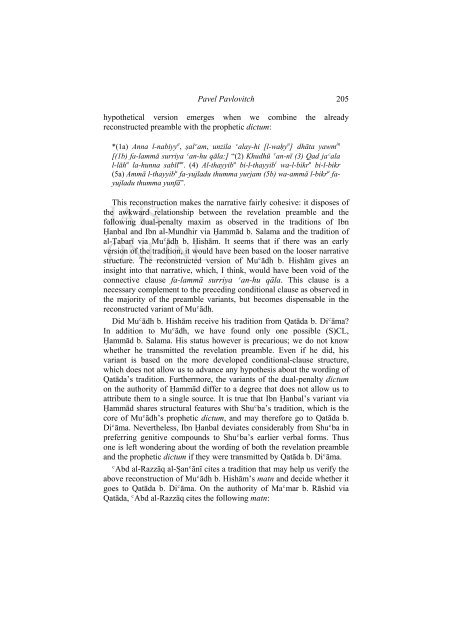JOURNAL OF ARABIC AND ISLAMIC STUDIES
JOURNAL OF ARABIC AND ISLAMIC STUDIES
JOURNAL OF ARABIC AND ISLAMIC STUDIES
Create successful ePaper yourself
Turn your PDF publications into a flip-book with our unique Google optimized e-Paper software.
JAIS<br />
ONLINE<br />
Pavel Pavlovitch<br />
205<br />
hypothetical version emerges when we combine the already<br />
reconstructed preamble with the prophetic dictum:<br />
*(1a) Anna l-nabiyy a , ṣalʿam, unzila ʿalay-hi [l-waḥy u ] dhāta yawm in<br />
[(1b) fa-lammā surriya ʿan-hu qāla:] “(2) Khudhū ʿan-nī (3) Qad jaʿala<br />
l-lāh u la-hunna sabīl an . (4) Al-thayyib u bi-l-thayyib i wa-l-bikr u bi-l-bikr<br />
(5a) Ammā l-thayyib u fa-yujladu thumma yurjam (5b) wa-ammā l-bikr u fayujladu<br />
thumma yunfā”.<br />
This reconstruction makes the narrative fairly cohesive: it disposes of<br />
the awkward relationship between the revelation preamble and the<br />
following dual-penalty maxim as observed in the traditions of Ibn<br />
Ḥanbal and Ibn al-Mundhir via Ḥammād b. Salama and the tradition of<br />
al-Ṭabarī via Muʿādh b. Hishām. It seems that if there was an early<br />
version of the tradition, it would have been based on the looser narrative<br />
structure. The reconstructed version of Muʿādh b. Hishām gives an<br />
insight into that narrative, which, I think, would have been void of the<br />
connective clause fa-lammā surriya ʿan-hu qāla. This clause is a<br />
necessary complement to the preceding conditional clause as observed in<br />
the majority of the preamble variants, but becomes dispensable in the<br />
reconstructed variant of Muʿādh.<br />
Did Muʿādh b. Hishām receive his tradition from Qatāda b. Diʿāma?<br />
In addition to Muʿādh, we have found only one possible (S)CL,<br />
Ḥammād b. Salama. His status however is precarious; we do not know<br />
whether he transmitted the revelation preamble. Even if he did, his<br />
variant is based on the more developed conditional-clause structure,<br />
which does not allow us to advance any hypothesis about the wording of<br />
Qatāda’s tradition. Furthermore, the variants of the dual-penalty dictum<br />
on the authority of Ḥammād differ to a degree that does not allow us to<br />
attribute them to a single source. It is true that Ibn Ḥanbal’s variant via<br />
Ḥammād shares structural features with Shuʿba’s tradition, which is the<br />
core of Muʿādh’s prophetic dictum, and may therefore go to Qatāda b.<br />
Diʿāma. Nevertheless, Ibn Ḥanbal deviates considerably from Shuʿba in<br />
preferring genitive compounds to Shuʿba’s earlier verbal forms. Thus<br />
one is left wondering about the wording of both the revelation preamble<br />
and the prophetic dictum if they were transmitted by Qatāda b. Diʿāma.<br />
ʿAbd al-Razzāq al-Ṣanʿānī cites a tradition that may help us verify the<br />
above reconstruction of Muʿādh b. Hishām’s matn and decide whether it<br />
goes to Qatāda b. Diʿāma. On the authority of Maʿmar b. Rāshid via<br />
Qatāda, ʿAbd al-Razzāq cites the following matn:

















